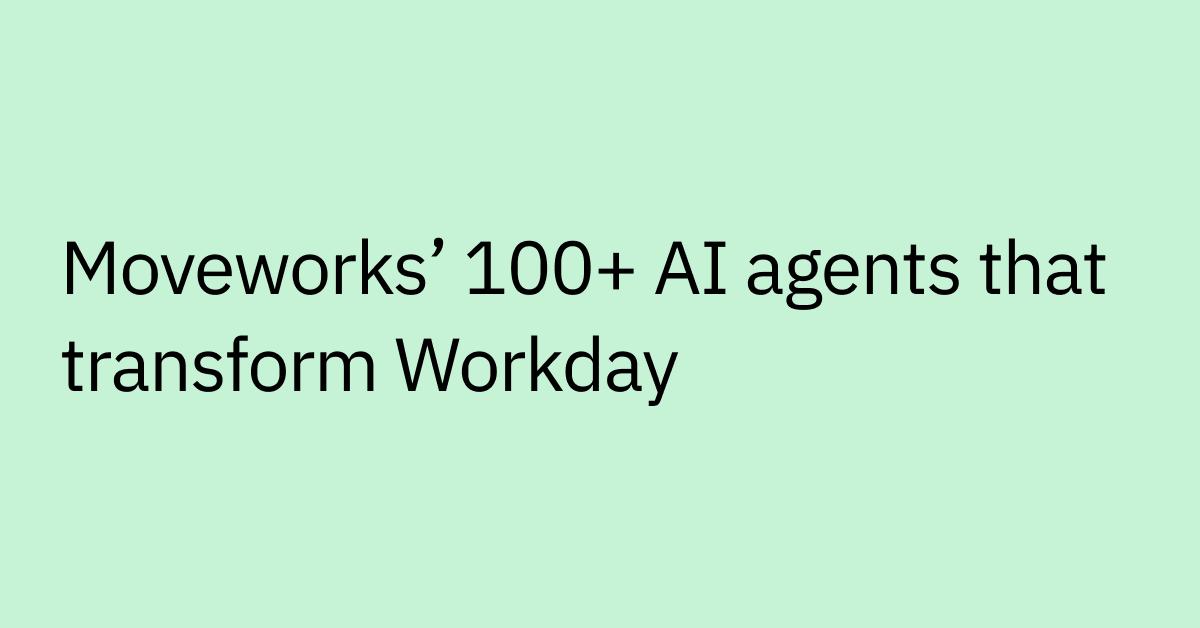Table of contents
Highlights
- Federated and indexed search are two core enterprise retrieval methods that determine how knowledge is accessed across systems.
- Federated search queries multiple live data sources in real time, making it ideal for dynamic or regulated environments where data can’t be centralized.
- Indexed search builds a pre-processed, centralized repository of content to deliver lightning-fast, consistent, and rankable results.
- AI enhances both techniques by interpreting intent, translating natural language queries, and improving result accuracy through semantic understanding.
- Moveworks Enterprise Search combines federated and indexed methods dynamically to provide secure, real-time, and contextually relevant answers at scale.
McKinsey says the average interaction worker spends an estimated 28 percent of the workweek managing e-mail and nearly 20 percent looking for internal information or tracking down colleagues who can help with specific tasks.
Finding information at work shouldn’t feel a major part of your job. But for many people, it can.
That’s because the average company uses more than 250 SaaS applications and many hundreds more when shadow IT is included.
No wonder employees don’t know where to look – and it’s costing them big time.
Enterprise search tools are meant to fix this. But here’s the catch: having a search bar doesn’t automatically make things better. What actually matters is how your search tool finds and delivers answers.
Behind the scenes, modern search systems rely on two core techniques:
- Federated search
- Indexed search
They’re often used together, but they work very differently — and choosing the right one (or both) can make all the difference.
Let’s break down what each method does, when to use them, how AI takes them to the next level, and why the smartest platforms combine both to help employees get the answers they need — without all the friction.
Enterprise search: The umbrella concept
Enterprise search refers to software that helps employees find information across a company’s internal systems. This includes everything from policies stored in Google Drive to tickets in IT help desks and conversations in collaboration platforms like Slack or Microsoft Teams.
The goal of enterprise search isn’t just to return results — it’s to deliver the right information in context, to the right person, at the right time. That means respecting access controls, understanding user intent, and retrieving content from a wide range of formats and tools.
To do that, enterprise search platforms rely on two main techniques:
- Federated search, which queries connected systems in real time
- Indexed search, which builds and queries a central repository of pre-processed content
Each technique has unique strengths and tradeoffs, and understanding them is key to designing an effective knowledge strategy.
What is federated search?
Federated search is a retrieval technique that enables users to search multiple live data sources simultaneously — without consolidating the data into one central location.
Instead of crawling and indexing the content ahead of time, the federated search system sends each query out to each connected source in real time, gathers the responses, and then displays them together.
This approach is particularly useful in environments where information is distributed across many siloed systems and cannot be easily migrated or copied.
Think of federated search like a meta-search engine. Travel websites such as Kayak or Expedia don’t store flight or hotel data themselves. Instead, they fetch results from various providers in real time and present them in a unified format.
Just like travel sites like Kayak don't store flight data, federated search fetches enterprise data from multiple systems in real time — without centralizing it. This approach allows organizations to access data from siloed systems securely and instantly, without duplicating or moving it.
In the enterprise context, federated search provides similar benefits. It allows organizations to surface insights across HR portals, third-party platforms, and cloud apps — without duplicating or ingesting sensitive data.
Why federated search matters
Federated search is often the best option when:
- Information is spread across dozens or even hundreds of platforms or third-party systems
- Data cannot be centrally stored due to privacy, compliance, or data residency constraints
- Employees need real-time access to the most up-to-date content, such as open tickets, inventory status, or company policies
In highly regulated industries like healthcare and finance, federated search allows companies to maintain strict control over data location while still enabling employees to find what they need.
In fact, half or more of an organization’s data is considered “dark” — data that is unknown, unused, or inaccessible. Federated search helps organizations unlock this hidden data by querying it in place, without disrupting ownership or compliance.
How federated search works
When a user enters a query, a federated search engine simultaneously sends that query to all integrated systems. Each system processes the query independently and returns its own set of results. The federated search platform then compiles and displays these results in one view.
This process is made possible through connectors or APIs, which:
- Convert queries into the format each system understands.
- Enforce user-specific access permissions.
- Normalize content from structured (e.g. databases) and unstructured (e.g. PDFs) sources.
Benefits of federated search
- Real-time freshness: Always reflects the most current data.
- No duplication: Avoids making copies of sensitive or regulated content.
- Faster setup: Quicker to start for a few sources; effort scales with number and complexity of connectors.
- Secure by design: Leverages existing access controls and permissions.
Limitations of federated search
- Slower response times: Performance depends on the speed of each data source.
- Limited functionality: Harder to support advanced features like ranking or personalization.
- Inconsistent UX: Results from different systems may vary in format and quality.
What is indexed search?
In contrast, indexed search builds a centralized index of all content ahead of time. This means the system ingests, analyzes, and stores data from various systems so that queries can be answered directly from the local index—rather than calling source systems in real time.
Think of indexed search like a library catalog. Instead of scanning every book every time someone asks a question, the system looks up pre-tagged entries that represent all available content.
Why indexed search matters
Indexed search is designed for speed and advanced functionality. By building a central knowledge repository, these systems can pre-process content using machine learning techniques, extract metadata, apply natural language processing (NLP), and generate semantic embeddings.
This enables:
- Lightning-fast response times
- Intelligent reranking of results
- Unified, consistent formatting
- Deep analytics on user behavior and content usage
For internal content like onboarding guides, policy documents, or engineering runbooks—where data updates are periodic rather than continuous — indexed search provides a superior user experience.
However, indexing requires more setup. You need data ingestion pipelines, regular synchronization schedules, and monitoring to ensure that stale content is refreshed. There’s also the matter of storage: indexing terabytes of enterprise content can be resource-intensive.
Tradeoffs of indexed search
While indexed search is great for fast and intelligent retrieval, it’s not ideal for every situation. If data changes frequently, or if access permissions change often, the index can become outdated without mitigations. That poses risks in environments where accuracy and recency are non-negotiable.
Additionally, some systems — like third-party SaaS tools or vendor-managed platforms—may restrict access to their data APIs, making indexing technically or legally challenging.
Federated vs. indexed: When to use each
Scenario | Best retrieval method |
Need real-time access to data in external systems | Federated search |
Want fast, personalized answers from internal docs | Indexed search |
Hybrid environments with both needs | Blended approach |
How AI enhances both techniques
AI doesn’t just improve search results — it transforms how employees interact with knowledge at work. By making enterprise search more intelligent and intuitive, AI helps teams get answers faster, with less effort and greater accuracy. Here's how it enhances both federated and indexed search:
For federated search, AI helps:
- Translate natural language queries into system-specific formats
- Interpret the intent behind vague or ambiguous searches
- Enrich and rerank results to improve consistency across sources
For indexed search, AI supercharges capabilities like:
- Semantic search, enabling users to ask questions in plain language
- Entity recognition, which tags people, places, and concepts automatically
- Query expansion and reranking, which refine results based on past interactions
In both cases, AI transforms enterprise search from a basic retrieval tool into a proactive assistant that anticipates user needs and delivers contextually rich answers.
Why leading platforms combine federated and indexed search
The most effective enterprise search platforms don’t force a choice between federated or indexed search. Instead, they use a dynamic approach that selects the right retrieval method in real time — based on the user’s query, access level, and the nature of the content.
Why the future of enterprise search is hybrid
When search doesn’t work, people waste time, ask around, or give up altogether. That adds friction to every part of work: onboarding, support, decision-making, and productivity.
The future of enterprise search lies in blending federated and indexed techniques — combined with AI — to deliver secure, relevant, real-time results at scale.
How Moveworks makes this possible
Employees shouldn’t have to guess where to search — they just need answers. That’s why Moveworks Enterprise Search dynamically combines both retrieval techniques, choosing the best method in real time based on the query, the source system, and the user’s access level.
An AI-powered platform like Moveworks Enterprise Search was built for today’s fragmented, fast-paced enterprise environments. Its dynamic retrieval framework uses both federated and indexed search behind the scenes — automatically choosing the ideal method for queries with a proprietary Reasoning Engine.
That means:
- Federated search for real-time data from external systems
- Indexed search for lightning-fast answers from ingested content
- AI-powered ranking and filtering to prioritize what matters most
- Granular permissions and integrations for secure, personalized results
With Moveworks, employees don’t have to guess where to search. They just get the answers — fast, relevant, and in context.
Ready to unify your enterprise knowledge? Learn more about Moveworks Enterprise Search.



